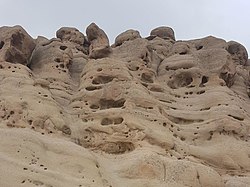Vardij (Persian: ورديج)[a] is a village in Sulqan Rural District of Kan District of Tehran County, Tehran province, Iran.
Vardij
Persian: ورديج | |
|---|---|
Village | |
 "Ghost stones" of Vardij | |
| Coordinates: 35°48′43″N 51°10′34″E / 35.81194°N 51.17611°E[1] | |
| Country | Iran |
| Province | Tehran |
| County | Tehran |
| District | Kan |
| Rural District | Sulqan |
| Elevation | 1,850 m (6,070 ft) |
| Population (2016)[2] | |
• Total | 778 |
| Time zone | UTC+3:30 (IRST) |
Vardij is popular for its "stone giants." The stones of the mountains have the appearance of giant human heads.[citation needed]
Demographics
editPopulation
editAt the time of the 2006 National Census, the village's population was 281 in 77 households.[4] The following census in 2011 counted 461 people in 144 households.[5] The 2016 census measured the population of the village as 778 people in 271 households. It was the most populous village in its rural district.[2]
See also
editNotes
editReferences
edit- ^ OpenStreetMap contributors (23 September 2024). "Vardij, Tehran County" (Map). OpenStreetMap (in Persian). Retrieved 23 September 2024.
- ^ a b Census of the Islamic Republic of Iran, 1395 (2016): Tehran Province. amar.org.ir (Report) (in Persian). The Statistical Center of Iran. Archived from the original (Excel) on 12 December 2021. Retrieved 19 December 2022.
- ^ Vardij can be found at GEOnet Names Server, at this link, by opening the Advanced Search box, entering "-3088166" in the "Unique Feature Id" form, and clicking on "Search Database".
- ^ Census of the Islamic Republic of Iran, 1385 (2006): Tehran Province. amar.org.ir (Report) (in Persian). The Statistical Center of Iran. Archived from the original (Excel) on 20 September 2011. Retrieved 25 September 2022.
- ^ Census of the Islamic Republic of Iran, 1390 (2011): Tehran Province. irandataportal.syr.edu (Report) (in Persian). The Statistical Center of Iran. Archived from the original (Excel) on 20 January 2023. Retrieved 19 December 2022 – via Iran Data Portal, Syracuse University.
